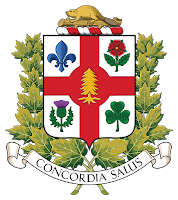“The Beaver in his sagacity, his industry, his ingenuity, and his
perseverance, is a most respectable animal: a much better emblem for Canada
than the rapacious eagle or even the lordly lion.”, claimed Sir William Dawson,
a Canadian geologist and university administrator in his book called The Duties of Educated Young Men in British
America. Although the beaver as one of the symbols of Canada has been the subject
of debate, it received the royal assent in 1975. But in the end, why is the
beaver the symbol of Canada?
The beaver is a herbivorous mammal that weighs between 16 and 35 kilos,
and can measure up to 1.3 meters. It is primarily nocturnal, and lives a
semi-aquatic life. The beaver is vegetarian, eating both aquatic and grass plants.
The beaver is an official symbol of the sovereignty of Canada, having
received royal assent in 1975. However, it was a part of the Canadian identity
long before Parliament passed the National Symbol of Canada Act. Over time, the
image of the beaver was used in other coats of arms (like that of Montreal’s)
and it appeared on the first Canadian postage stamp, the « Three Penny Beaver »
of 1851. After that the decline in use was evident in Canada. Companies and
government used the image of the beaver for representative and monetary
purposes, because the beaver lived in every province of Canada.
Historically, the beaver was central to Canada’s beginnings. In the
1600’s and early 1700’s, the beaver became an animal in much demand due to the
fur trade. Fur hats became extremely fashionable in Europe. Because North
America had a massive beaver population, English and French traders soon became
the biggest predators of the beaver. They sold it at a cheaper price than the
original one of the North American aboriginals. This lucrative fur trade was
the basis of the North American colonies. Due to this market, the beaver almost
went extinct. However, thanks to many protective measures, the beaver
population reappeared across Canada once again. It was in 1673 that the beaver
was first suggested to the authorities as the symbol of Canada.
The beaver’s merits as the national symbol has been debated for a long
time. On one hand, some historians claim that it has a rather negative
connotation, because the beaver was used for the economy by the crafty natives who
found good deals and almost led the animal to extinction. On the other hand,
the director of archaeology and history at the Canadian Museum of History in Hull has declared that the beaver
reflects the character of the Indian population: hard-working, unassuming and
unaggressive.
The beaver has an incredible biological importance. Without beavers’
dams, much of the water of Canada’s streams would flow without any control
through the landscape. By diverting water and felling trees, they provide
themselves with wood and food but also give access to dense woods, creating
opportunities for a variety of animals and plants. For these reasons, they are
one of the most important animal species of the Boreal Forest.
Although the beaver has been debated for its role as the national
symbol of Canada, it is still and will be a representative for Canada, thanks
to its character and importance for the environment.
Chloé Bourian, Sophie De Gelan, Juliette Depauw
SOURCES



No comments:
Post a Comment